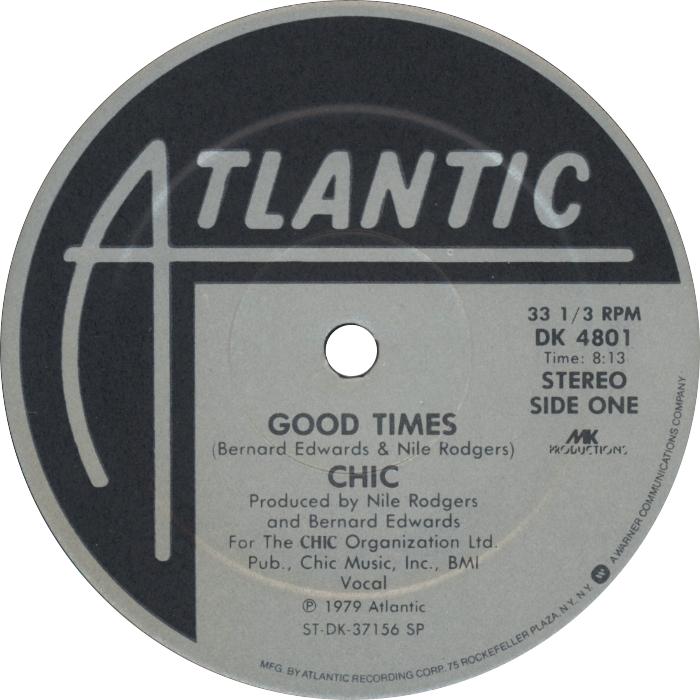Chic’s “Good Times” Reverberates Across the Village, and the World
The song “Good Times” by disco-funk band Chic is more than just a catchy tune that encapsulates the carefree party spirit of the late 1970s. Ranked number 68 on the list of all time great songs of the rock era by Rolling Stone magazine, it not only epitomized the disco era, but quite quickly helped transform the nascent musical form known as hip hop from a phenomenon little known outside of a small number of urban communities in New York City, where it was almost exclusively a live-performance event, into a recorded, transmissible, worldwide trend. The man most responsible for the song was born and raised in Greenwich Village and the East Village — neighborhoods whose bohemian mixes he credits with helping to shape his own unique musical sensibilities. And neighborhoods which, perhaps not coincidentally, played a large role in helping to shape and spread hip hop, which traces its birth to a party in a recreation room in a housing development in the Bronx on August 11, 1973.

Chic released “Good Times” on June 4, 1979, and it quickly shot to Number 1 on the U.S. Billboard charts. It reached that mark on August 18, 1979, becoming the band’s second U.S. Billboard Number 1. The song was written and produced by the guitar and bass team of Nile Rodgers and Bernard Edwards, who formed the core and creative heart of the New York City-based Chic. As we’ve previously written, Rodgers, who went on to write and produce hits for a phenomenal array of musicians, from David Bowie to Daft Punk and Madonna, grew up in Greenwich Village and Alphabet City, and was exposed to a multi-racial, multi-ethnic, multi-cultural stew of musical and artistic influences, which helped shape his own eclectic and expansive style over the years.

As popular as “Good Times” was and as much as it exemplified its era, it would be Chic’s last number one song, and the band would break up not long after its success (though they would reunite in later years, and Rodgers, Edwards, and other members of the band would have successful musical careers in the decades that followed — on their own and in various combinations with one another). 1979 was by most accounts the end of the disco era, and “Good Times” was edged out of the Number 1 spot on the charts by another, very different kind of earworm: “My Sharona” by The Knack. That punk-inflected powerpop tune was emblematic of one of the two emerging musical cross-currents that would soon overshadow and subsume disco, and bands like Chic. But interestingly, the other style that would help end disco’s reign was one that Chic, and “Good Times” in particular, was in many ways partly responsible for the emergence of.

“Good Times”’ infectious groove made an impression across the globe. But perhaps nowhere more so than with some young rappers from New Jersey. Just weeks after the hit was released, on August 12, 1979, “Big Bank Hank” Jackson, “Wonder Mike” Wright, and “Master Gee” O’Brien, who collectively went by the monicker “the Sugar Hill Gang” (after the legendary Harlem neighborhood, though they were from Englewood, New Jersey, across the Hudson) were in a recording studio interpolating the unmistakable bass line and guitar riffs from the song, turning them into a loop of sorts (an analog version of what sampling would soon do, mimicking what DJs and teenagers with boomboxes and tape decks were doing at “hip hops” in playgrounds and bowling alleys and schools across the Bronx), and rapping over it, creating what they would call “Rapper’s Delight.” The song, one of the first recorded rap songs to get any kind of widespread airplay in the United States, was released just six weeks later, on September 16, 1979. Though it reached only a modest number 36 on the U.S. Billboard charts, on January 5, 1980, it became the very first hip hop Top 40 hit in the U.S. It was also phenomenally popular on American urban/black/dance music charts, and would top the mainstream charts in Canada, the Netherlands, and Spain, and come close to the top in the United Kingdom and West Germany, thus beginning hip hop’s international conquest. As illustration of the genre’s quick ascent and disco’s decline, “Rapper’s Delight” actually outperformed “Good Times” on the charts in Canada and several European countries, even as both were simultaneously in circulation and getting airplay.

Initially uncredited as a co-writer of the song, Rodgers threatened legal action, and he and the Sugarhill Gang quickly settled. Rodgers and Edwards’ names were added to the copyright for the groundbreaking song, and Rodgers embraces his role in helping to lay the foundation for the global explosion of rap and hip hop, and of the Sugar Hill Gang and other pioneers in creating something altogether new and exciting out of his work. “Rapper’s Delight” would eventually join “Good Times” on the Rolling Stone list of the 500 greatest songs of all time.

To learn more about Nile Rodgers, see here. To learn more about Hip Hop history in Greenwich Village, NoHo, and the East Village’s, explore our Hip Hop StoryMap.
